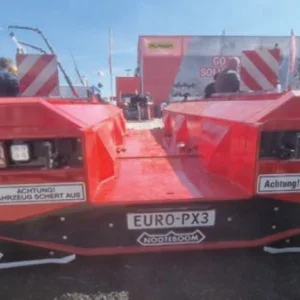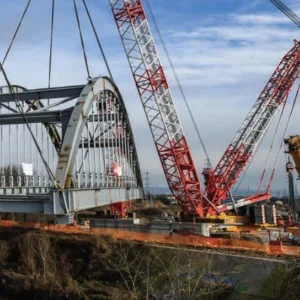Soufflet Grain is a major UK exporter of grain. Earlier this year, there was concern over the structural integrity of Soufflet Grain’s crane at Southampton Docks. The ship loader crane is used for loading ships with wheat and cereal at a rate of over 1,000t per hour. It has been in service there since 1982.
A replacement crane was estimated to cost anything up to £1m ($1.5m). Soufflet Grain appointed consulting engineer WF Brown Associates to carry out a specialist structural survey to assess the situation and see if there was an alternative to replacement.
The ship loader was ‘made’ in 1982 by adapting an old dockside crane to carry a bucket elevator and chain conveyor. The original dockside crane was reportedly built in 1946 by Stothard & Pitt and is of all-riveted construction. The adaptation in 1982 was of welded and bolted construction, and was carried out by Redler Conveyors.
In its survey, WF Brown determined both overall sizes and section sizes. Areas of natural corrosion were logged, the loader was observed in operation feeding grain into a ship moored alongside, and the existing fabrication drawings were reviewed. Other non-destructive tests were carried out to determine the thickness of the original metal and the percentage of material lost due to corrosion. Measurements were made ultrasonically and by a vernier depth gauge.
The consulting engineer entered the crane structure into a three-dimensional model analysis program to assess stress concentrations in the framing. The model was created in two parts, basically splitting the structure between the 1946 structure and the 1982 additions.
WF Brown did indeed come up with a solution to give the old crane another 10 years of useful life. It recommended that the framework of the 1946 structure was repaired and reinforced by the addition of 10mm thick plate and angle or channel sections to reinstate the members to their original cross-sectional area.
Rivets with corrosion on the projecting head were drilled out and the resultant hole was reamed out to the next size hole and a close tolerance bolt installed. Sections that had lost a significant percentage of their cross section were replaced with a like-for-like section alongside. This mainly applied to light bracing angles used to batten two principal members together. The 1980s structure required only minimal repair, involving reinforcement to corroded welds, usually in recessed corners and crevices. The entire structure was then covered with a high specification coating system, appropriate to the severe exposure conditions in which the structure operates.
The exact cost savings have not been disclosed, but Scott Ritchie of Soufflet Grain says: ‘We are very grateful for this less expensive solution. WF Brown director Nick Groves says: ‘There are many occasions where engineering consultancy advice saves significant amounts on construction projects, although not every firm takes advantage of it. In Soufflet Grain’s case the benefits are clear.’






